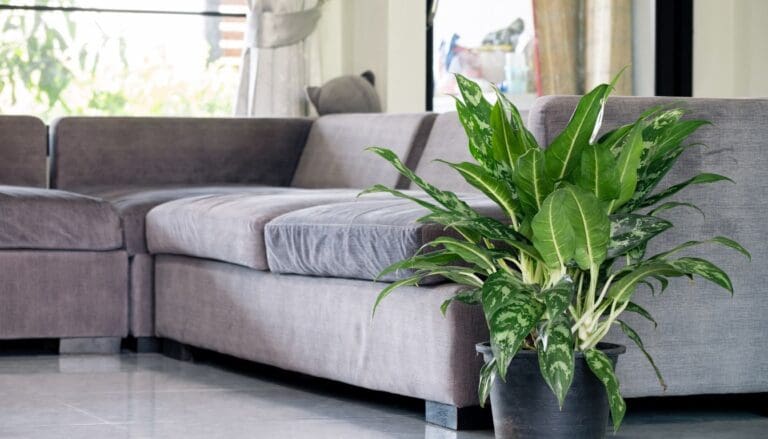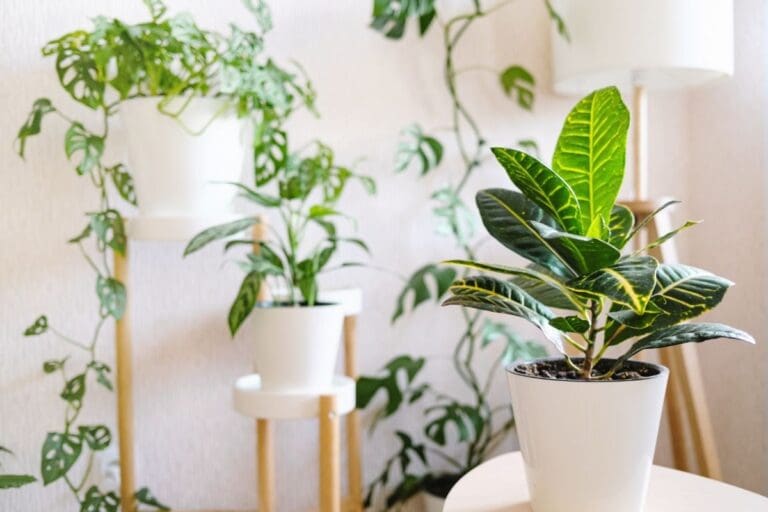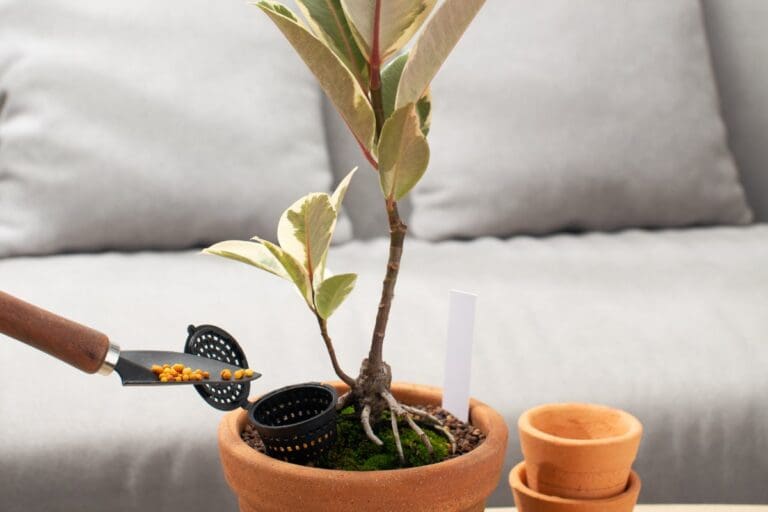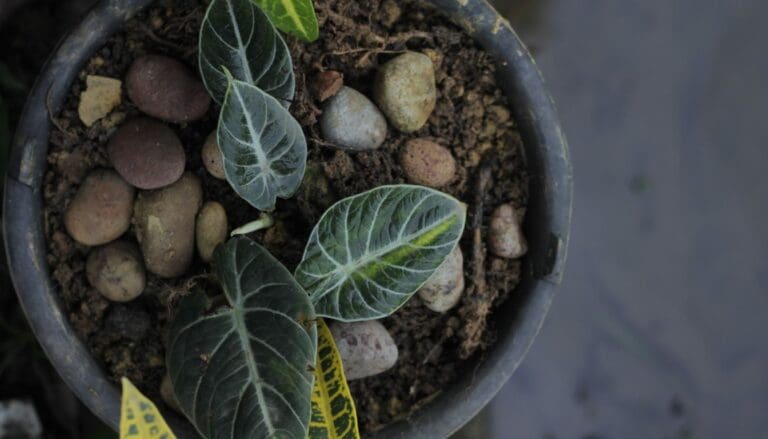Why Is My Jade Plant Losing Leaves? (Causes+What To Do)
Jade plants are sturdy and easy to maintain. They don’t get affected easily, but ignorance can keep them unhappy and lead to several issues. If we don’t provide adequate care to them, they are likely to lose their leaves. Therefore, it is essential to know what is upsetting your jade plant and why they are losing leaves.
The primary causes of dropping leaves in jade plants are overwatering, lack of sunlight, and nutrient deficiency. A pest infestation and bacterial or fungal infection can also lead to the loss of leaves in a jade plant. Please provide them with an appropriate living environment to keep them healthy.
Jade plants are not very demanding, but you need a little bit of effort to keep them healthy and in good shape. However, they can be grown into beautiful houseplants by keeping some points in check.
We have given a complete care guide so that you will be able to identify the reason and immediately fix it with the proper solution.
Please read below to learn why your jade plant is losing leaves and their solutions.
Please note: Simplify Plants is reader-supported. Some links in the post are affiliate links and I get a commission from purchases made through links in the post.
Incorrect watering

Incorrect watering can be a major reason for your jade plants losing leaves. Jade plants do not appreciate over watering and under watering for a long time; it can stress them.
Causes
When jade plants are under-watered for a long time, they can go into stress. They are known to favor a dry state more than a wet one.
Unfortunately, most planters don’t take it sincerely and neglect the water requirements of their jade plants.
The soil and roots lack water and nutrients and cannot supply them to their leaves and stems.
The leaves lose their moisture and nutrients; as a result, they lose strength and fall off. In addition, the lower leaves also start to shrivel and fall off if they are under-watered.
Similarly, overwatering your jade plants is like slowly killing them. Some might do this out of love or expectation of fast growth.
However, the excess water in soil and roots can choke them, restricting them from absorbing sufficient nutrients and water for their other parts.
As a result, the leaves turn yellow and fall off. This condition can stunt their growth, and you may lose your plant forever.
Solution
Underwatering can be corrected by following the given steps:
- Soak your jade plant in water for some time.
- Let the excess water drain out completely.
- Let the plant dry completely.
- Water it again thoroughly and let it dry out.
- Water next only when the soil is dry up to 2-3 inches from within.
- You can also use a moisture meter to check if the soil needs watering.
The overwatered jade plant can be fixed in the following steps:
- Let the jade plant dry thoroughly and naturally by giving it bright indirect light.
- Clip any damaged leaves and branches.
- Check the drainage system to ensure excess water is draining correctly.
- Check the soil by digging your finger up to a few inches in the soil. Water only when it feels dry.
- Repot if the condition is out of hand.
Also read: How often should I water my jade plants?
Insufficient light

Jade plants are light lovers and thrive best in a well-lit space. They are the healthiest and happiest when exposed to bright light. They prefer both direct and indirect light but in the right balance.
Causes
Jade plants need light to maintain their green and glossy leaves. Due to lack of light, the photosynthesis process slows down, the chlorophyll production reduces. As a result, they lack energy, start drooping and then fall off.
Light is required to utilize the food and water your jade plant is getting.
If the light is scarce, the plant cannot properly use its food and water, which will then work against them. The soil will also stay wet for long, creating scope for root rot or fungal growth.
All these often lead to leaf loss. This happens at the beginning of winter because the sun is not too intense, and water takes a lot longer to evaporate and dry out.
Solution
- During summers, find a spot for your jade plant where it can get 4-6 hours of indirect light and 3-4 hours of direct light.
- The direct light should not be harsh; morning and late afternoon direct sun is fine.
- During winter, move your plant outdoors in the daytime for direct light, as they may not receive enough light indoors.
- You can move them indoors at dawn to prevent them from cold drafts.
- You can use artificial light sources for your jade plant to fulfill its light needs. Keeping them under or near the lamp also helps.
Also read: How much light do jade plant needs?
Poor drainage

Sometimes even after following the proper watering routine, you might overwater your jade plant, and the primary reason for this is a poor drainage system.
Since the water cannot escape the pot, it keeps the soil soggy leading to root rot.
Causes
Jade plants growing in pots with poor drainage systems can become prey to overwatering. This is because the soil stays wet for so long, sequentially attracting root rot situations.
The transport of nutrients and water from soil and roots to other parts of the plants deters.
Since the roots and soil are already unable to assimilate nutrients and water, the other parts also begin to suffer due to the lack of nutrients.
As a result, your jade plants lose their leaves which can be considered a few of the initial signs of overwatering and root rot. These signs should be taken seriously and act over.
Solution
It would be best if you fix the drainage asap because it is likely going to cause root rot in your jade plants. Do the following to fix it:
- Stop watering till your plant dries out completely.
- Inspect the drainage system of your pot. The excess water should come out within 2 minutes of watering if the drainage system is decent.
- Shift your jade plant to another pot with proper drainage holes if the present pot has a poor drainage system.
- Always check your soil by digging a finger/skewer in few inches from the topsoil, take it out, and check if the soil feels dry or moist.
- Water only when the soil feels dry.
- Use well-draining soil to allow the excess liquid to drain out quickly.
The wrong type of soil

Soil is the base of any plant and the ultimate source of nutrients and water for them.
However, they lose their nutrients with regular watering, which needs to be renewed with fertilizing.
Causes
If the soil you are using for growing your jade plant is not suitable for them, your plants are likely to suffer.
The leaves turn yellow, fall off as they are not growing in the correct type of soil.
The soil mix is either very heavy or lacks the nutrients required by the plant to sustain its health.
If the soil is heavy, it may be soaked in water, forming perfect conditions for root rot.
If the soil lacks the required nutrients, the plant may suffer due to nutrient lack.
The plant is not fed with fertilizer at the right time leading to nutrient deficiency. As a result, the leaves and other parts are not getting ample nutrients to maintain their color firmness and lose their vigor and fall off.
Solution
- If the soil mix is heavy, then repot your jade plant with a healthy well-draining potting mix.
- Choose a well-draining soil mix formulated for succulents.
- You can make your own by mixing two parts of the well-draining succulent soil mix and 1 part perlite.
- If you are not fertilizing your plant correctly, buy a nitrogen-rich fertilizer for your jade plant.
- Feed them by diluting the fertilizer to half the strength to avoid overfertilization.
- Water your plant before fertilizing to permit nutrients to distribute evenly in the soil.
Also read: Best soil mix for jade plants?
Pests infestation

Jade plants are tough plants and cannot be easily affected by pests.
However, some common pests that affect jade plants are mealybugs, spider mites, aphids, and scales.
Causes
Jade plants can be affected by these stubborn, tiny pests primarily due to the wet environment. When the soil stays wet all the time, the pests find such areas through their sixth sense.
So they stay in the plant, and if the moist conditions persist, they start multiplying; thus, they take over your plants altogether.
Your jade plant may be infected due to other pest-infested plants in their surroundings. Another cause could be newly bought plants.
Often planters buy new plants and place them with their old plants. If the new plant is already infested, then it will infest your new plants as well.
These pests keep sucking the juice out of the plant, making the plant weak. The leaves start yellowing, drooping, and then fall off as they completely lose their energy.
Solution
- Always keep a newly bought plant in isolation till everything seems fine in it.
- You can use your hands to remove bugs as much as you can.
- Use neem oil spray by mixing 2 tbsp neem oil into 1-gallon water. Spray it on the plant every day till all the bugs and eggs are killed.
- You can use rubbing alcohol, dip a cotton swab in rubbing alcohol, and gently wipe the plant to remove all the bugs.
- You can also opt for chemical pesticides and use them if the infestation continues.
- Please read the instructions properly before buying to make sure it is suitable for your plant and use it by diluting it to half the strength as recommended.
Also read: How to get rid of bugs on jade plants?
Temperature fluctuations

Temperature fluctuations are another common problem that leads to the dropping of leaves in a jade plant.
When the temperature level changes suddenly, it stresses the plant, which leads to leaf loss.
Causes
Jade plants can tolerate a variety of temperature ranges. This doesn’t mean you keep them in extreme conditions. They don’t appreciate extreme or sudden shifts in temperature.
If a jade plant is kept in an area where the temperature changes frequently, the leaves are likely to fall off.
Jade plants do not perform well in the winter months due to frost. They can survive low temperatures, but cold drafts and frost can give them a hard time. In addition, they may lose leaves as a sign of shock.
Solution
- Do not move your jade plant from one place to another frequently.
- Please keep them in an area with a temperature between 65°F-85°F.
- Move them indoors during the winter month and keep them away from windows to prevent temperature shock.
- Keep them away from vents, radiators, furnaces, etc.
- Keep them dry during winter as they can permanently get stressed if kept wet in cooler months for longer periods.
- Move them to a ventilated area to make sure it gets good airflow.
Also read: Where to keep jade plants at home?
Older leaves falling off

It is natural for any plant to lose its older leaves as it grows and matures.
The new growth will take place, and some old leaves will fall off. There is no need to worry if something like this happens with your jade plants.
Causes
Jade plants losing leaves does not always mean doom and gloom. They may be fine, and it might just be an old leaf that needs to fall off eventually.
It is typically the life cycle of a jade plant which is not something questionable. They naturally drop their older leaves as a process of aging.
These dropped leaves are replaced with new growth as the growing season progresses.
However, if they are dropping leaves abnormally, then you might consider checking on them to identify possible problems.
Solution
- Let your plant be when the plant is losing leaves naturally.
- Always keep a check on your plant to understand its typical leaf dropping rate.
- Inspect them if you feel they are dropping excessively and take action accordingly.
- Look for the possible reasons for the stress of your plant and fix it.
Will jade plant leaves grow back?
Once the leaves fall off or turn yellow or brown, they will not get healthy again. However, your jade plant will produce fresh new leaves once it gets acclimated to the new environment.
You can do a few things to support the growth of new branches and leaves.
- Prune your jade plant during early spring. Prune up to 30% of the leaves. You can plan to prune in stages every week to avoid over-pruning.
- You can pinch back young stems using your forefinger to encourage branching and new leaf growth.
- Provide your plant with ample direct and indirect light in the right proportion as they need the energy to have new growth.
- Fertilizing in the early summer will also help to give them a boost of nutrients to support soil and roots to produce new leaves and stems.
Final words
Jade plants are sturdy and beautiful plants that are very rarely seen to be sinking due to issues.
All you need is to keep an eye on your jade plant and prevent them from extreme conditions.
Following the proper process, enjoying the process, and creating a prime living atmosphere for them is the best you can do.
Source: NYBG, The University of Arkansas, University of Florida, Phytochemical and Antimicrobial Activity of Jade Plant, CABI, University of Minnesota, The University of Missouri.
Recommended Garden Supplies
| Product Image | Our Recommended Gardening Supplies | Check Offers! |
|---|---|---|
Top Top
Top
Top
Top
Top
Top
Top
Top | rePotme Houseplant and Tropical Classic Potting Soil Mix | Check Offer On Amazon |
 Top
Top
Top
Top
Top
Top
Top
Top | Espoma Organic Indoor Plant Food | Check Offer On Amazon |
 Top
Top
Top
Top
Top
Top
Top
Top | GooingTop LED Grow Light 6000K Full Spectrum Clip Plant Growing Lamp | Check Offer On Amazon |
 Top
Top
Top
Top
Top
Top
Top
Top | Soil Moisture Meter | Check Offer On Amazon |
 Top
Top
Top
Top
Top
Top
Top
Top | Govee Hygrometer Thermometer, Bluetooth Enabled! | Check Offer On Amazon |
 Top
Top | LEVOIT Humidifiers for Large Room(Best For Plants) | Check Offer On Amazon |
 Top
Top
Top
Top
Top
Top
Top
Top | Upgraded DIY Automatic Drip Irrigation Kit, 15 Potted Houseplants Support | Check Offer On Amazon |
 Top
Top
Top
Top
Top
Top
Top
Top | Stainless Steel Heavy Duty Gardening Tool Set | Check Offer On Amazon |
 Top
Top
Top
Top
Top
Top
Top
Top | Bonide Insecticidal Soap | Check Offer On Amazon |
 Top
Top
Top
Top
Top
Top
Top
Top | Bonide 32 oz Spray Neem Oil for Organic Gardening | Check Offer On Amazon |
 Top
Top
Top
Top
Top
Top
Top
Top | Garden Safe Fungicide | Check Offer On Amazon |






